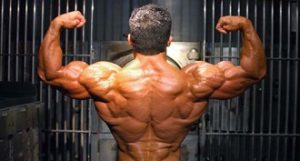Bodybuilders are infamous for over-complicating the “angle game” in their training. This usually leads to the addition of too many redundant movements for any given body part. While I appreciate the proactive element of this mindset, overtime, it can add unrequired training-time which depreciates the quality of your sessions.  In some cases it may even slow down or stall the rate at which you progress. With that said, the topic of how much volume and exercise variation is optimal is a broad one, and perhaps better left for another blog entry at a later time. What I would like to go over is a muscle group that is able to benefit from playing the “angle game” because it may require a little more exercise variety than other muscle groups.
In some cases it may even slow down or stall the rate at which you progress. With that said, the topic of how much volume and exercise variation is optimal is a broad one, and perhaps better left for another blog entry at a later time. What I would like to go over is a muscle group that is able to benefit from playing the “angle game” because it may require a little more exercise variety than other muscle groups.
Top: Doug Miller showcasing some of the most complete back development in the world.
The entire back musculature is one that, when fully developed, can take a while to fully scan and appreciate. It’s the only muscle group in bodybuilding that has three different mandatory poses dedicated to it in order to properly display it. Those poses are: Back Relaxed, Back Double Biceps, and Back Lat Spread. As a true bodybuilding fan, I could go on… but, I simply wanted to remind you of the fact that there are many different muscles with a variety of functions “zig-zagging” all over the back of your torso. Even within the same muscle group, you are able to see how different fibers have slightly different lines of pull based on their origin. With this observation, perhaps you can see why playing the “angle game” might make sense for this muscle group.
Today, I would like to go over a piece of equipment that is actually quite common in most gyms. Going off of observation, this machine is often overlooked or, at the very least, not fully appreciated. First and foremost, I am going to have to give credit where credit is due. The first High Row that was popularized was the Hammer Strength line. Since then, many other companies have created their own version of this unique machine.
What makes the HR such a great piece of equipment is that it stimulates many muscle fibers that you really can’t target as effectively with free weights. Sure, you can use a pulley system and simply angle your torso in a similar position. However, when you do this, counterbalancing your body can then be the limiting factor. In addition to this downfall, most pulling movements where the torso is left unsupported are prone to changes in technique once fatigue sets in. With the HR, you are free to row while the revolutionary angle of the machine does its job to put you in a position that targets muscle fibers that are often partially neglected while using free weights. I am specifically referring to some of the Latissimus Dorsi muscles that originate from the higher thoracic spine as well as the lower trapezius muscle fibers. Bodybuilders love the idea of having upper traps that touch their ears, but they tend to forget that this muscle is shaped like a kite. A note-worthy portion of its potential contribution to back thickness runs in almost the exact opposite direction as the upper traps.
Left to Right: Trapezius and latissimus dorsi muscle
Top: Natural Pro Champion Jim Cordova dominated the late 2000’s Natural Bodybuilding scene, and back poses that were hard to forget.
Disclaimer: by absolutely no means am I saying you to will have a back like Jim Cordova or Doug Miller because you started using a HR. However, you can certainly appreciate how amazing that area looks when it’s well developed.
Another reason I love the HR, is because of its practicality in the fact that it covers most angles. There have been times during this offseason where the HR has been both my primary horizontal row while also being my vertical pull of choice. Currently, I am almost exclusively performing the HR along with the pull-over variation that I went over a few blog posts prior. I love this machine because it’s innovative, but also very practical. I figured I would show it some love because most people usually walk by it and think of it as “just another back machine”. Furthermore, it’s very common in most gyms and most of the models I have seen are truly “one size fits most”. So, give it a shot and see how you like it for those “hard to reach” back muscles, hopefully they will thank you!
Until next time guys! Maybe I will do the “Hammer Strength H-Squat”… no, no I am kidding folks. But do me a favor and go ahead and Google that one for a laugh.






Hahaha alberto just youtubed hammer strength h squat wow that is some exercise. looks sort dangerous vertigo inducing. working at height
Seeing this video on YouTube in Alberto’s back workout, has created a rounded understanding of back training related to muscle development. Simply amazing! 😃